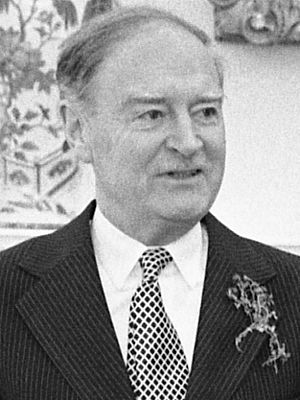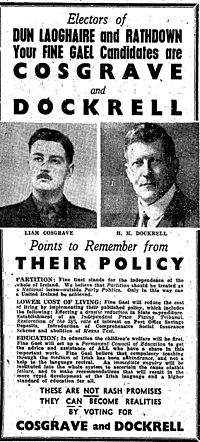Liam Cosgrave facts for kids
Quick facts for kids
Liam Cosgrave
|
|
|---|---|

Cosgrave in 1976
|
|
| 6th Taoiseach | |
| In office 14 March 1973 – 5 July 1977 |
|
| President | Éamon de Valera Erskine H. Childers Cearbhall Ó Dálaigh Patrick Hillery |
| Tánaiste | Brendan Corish |
| Preceded by | Jack Lynch |
| Succeeded by | Jack Lynch |
| Leader of the Opposition | |
| In office 21 April 1965 – 14 March 1973 |
|
| Taoiseach |
|
| Preceded by | James Dillon |
| Succeeded by | Jack Lynch |
| Leader of Fine Gael | |
| In office 21 April 1965 – 1 July 1977 |
|
| Deputy | Tom O'Higgins |
| Preceded by | James Dillon |
| Succeeded by | Garret FitzGerald |
| Minister for External Affairs | |
| In office 2 June 1954 – 20 March 1957 |
|
| Taoiseach | John A. Costello |
| Preceded by | Frank Aiken |
| Succeeded by | Frank Aiken |
| Parliamentary Secretary | |
| 1948–1951 | Government Chief Whip |
| 1948–1951 | Industry and Commerce |
| Teachta Dála | |
| In office June 1977 – June 1981 |
|
| Constituency | Dún Laoghaire |
| In office February 1948 – June 1977 |
|
| Constituency | Dún Laoghaire and Rathdown |
| In office June 1943 – February 1948 |
|
| Constituency | Dublin County |
| Personal details | |
| Born | 13 April 1920 Castleknock, Dublin, Ireland |
| Died | 4 October 2017 (aged 97) Tallaght, Dublin, Ireland |
| Resting place | Goldenbridge Cemetery, Inchicore, Dublin, Ireland |
| Political party | Fine Gael |
| Spouse |
Vera Osborne
(m. 1952; death 2016) |
| Children | 3, including Liam |
| Parents |
|
| Education |
|
| Alma mater | King's Inns |
Liam Cosgrave (born 13 April 1920 – died 4 October 2017) was an important Irish politician. He was the Taoiseach (Ireland's Prime Minister) from 1973 to 1977. He also led the Fine Gael political party from 1965 to 1977.
Liam Cosgrave was the son of W. T. Cosgrave, who was the first leader of the Irish Free State. Liam became a lawyer before starting his political career. He was first elected to Dáil Éireann (the Irish Parliament) in 1943. He served as a Teachta Dála (TD), which is like a Member of Parliament, until 1981.
Contents
Liam Cosgrave's Early Life and Education
Liam Cosgrave was born in Castleknock, Dublin. His father, W. T. Cosgrave, was a very famous politician. From a young age, Liam was interested in politics. He joined the Fine Gael party when he was just 17.
He went to school at Synge Street CBS and Castleknock College in Dublin. Later, he studied law at King's Inns. In 1943, he became a qualified lawyer.
Starting His Political Journey
Becoming a Young TD
In 1943, Liam Cosgrave decided to run for election to Dáil Éireann. He was only 23 years old when he was elected as a TD for Dublin County. His father was also a TD at the time.
Fine Gael was not in power during this period. Liam quickly became known as one of the most active and skilled new TDs in his party.
First Government Roles
In 1948, Fine Gael formed a government with other parties. The Taoiseach, John A. Costello, chose Liam Cosgrave for two important roles. He became a Parliamentary Secretary to the Taoiseach and the Government Chief Whip. He also served as a Parliamentary Secretary for Industry and Commerce. He held these jobs until 1951.
Serving as a Minister
Minister for External Affairs
After the 1954 election, Fine Gael was back in government. Liam Cosgrave, at 34, was made Minister for External Affairs. This job is now called Minister for Foreign Affairs.
One of his biggest achievements was helping Ireland join the United Nations in 1955. He explained that Ireland's foreign policy would follow UN rules, be independent, and support countries defending freedom against communism.
Challenges in Government
The government faced economic problems. Liam Cosgrave believed that the Minister for Finance, Gerard Sweetman, was responsible for Fine Gael losing the 1957 election. This caused a disagreement between them for many years.
Leading the Opposition
Party Leadership Contest
In 1959, the leaders of Fine Gael, Richard Mulcahy and John A. Costello, stepped down. Liam Cosgrave ran for the leadership against James Dillon. Dillon won the election and became the new leader.
New Ideas for Fine Gael
During the 1960s, some members of Fine Gael wanted the party to become more focused on social issues. They proposed ideas called the Just Society, which suggested more government spending on health and social welfare. Even though Liam Cosgrave was generally conservative, he was somewhat open to these new ideas.
Becoming Fine Gael Leader
In 1965, James Dillon resigned as leader of Fine Gael. Liam Cosgrave was then easily elected as the new leader. He led the party in the 1969 election but lost to Jack Lynch of Fianna Fáil.
The Arms Crisis
A major event happened in 1970, known as the Arms Crisis. As Leader of the Opposition, Liam Cosgrave played a key role. He put pressure on Taoiseach Jack Lynch to investigate some senior ministers. These ministers were suspected of trying to illegally import weapons for a group called the Provisional IRA. Information about this was given to Cosgrave by the police.
Standing Firm on Security
Cosgrave strongly supported the government's laws against terrorism, even when some members of his own party disagreed. He believed that protecting the country was most important. In 1972, he gave a famous speech where he criticized those who opposed strong security measures. He said he would "dig them out" like "mongrel foxes." This showed his strong stance on law and order.
Taoiseach (1973–1977)
After the 1973 election, Liam Cosgrave became Taoiseach. He led a coalition government made up of Fine Gael and the Labour Party. They had a plan with fourteen points they wanted to achieve.
His government included well-known figures like Garret FitzGerald and Conor Cruise O'Brien. Cosgrave chose Richie Ryan as his Minister for Finance. Ryan introduced new taxes on wealth and capital gains, which were unpopular with some wealthy people.
Economic Challenges
The world faced an energy crisis in 1973, which caused prices to rise. This made it difficult for Cosgrave's government to manage the economy.
Disagreements with the President
Cosgrave's government had some disagreements with the President of Ireland. In 1973, the Fine Gael candidate lost the presidential election to Erskine Hamilton Childers. Childers wanted to make the President's role more active, but Cosgrave disagreed.
When Childers died in 1974, Cearbhall Ó Dálaigh became the new President. Ó Dálaigh was known for protecting free speech. He was critical of a law that stopped the voices of Sinn Féin members from being broadcast. This caused tension with Cosgrave's government, which had made the law stricter.
In 1976, after a British Ambassador was killed by the IRA, the government introduced a new law called the Emergency Powers Bill. President Ó Dálaigh sent the bill to the Supreme Court to check if it was constitutional. Although the Court approved it, a police officer was killed by the IRA on the same day. The government was very angry and blamed the President for the delay.
The Minister for Defence, Paddy Donegan, publicly called the President a "thundering disgrace." Cosgrave refused to accept Donegan's resignation, which led President Ó Dálaigh to resign himself. He said he resigned "to protect the dignity and independence of the presidency."
Northern Ireland Peace Efforts
In December 1973, Cosgrave's government signed the Sunningdale Agreement. This was an attempt to bring peace to Northern Ireland. It aimed to set up a power-sharing government and a Council of Ireland. However, the agreement collapsed in May 1974 after a strike by workers in Northern Ireland.
The government also faced criticism for its handling of the Dublin and Monaghan bombings. A report in 2003 suggested that the government did not do enough to investigate these bombings or pressure the British government for help.
Economic and Social Changes
The Cosgrave government introduced tough economic measures. This made them unpopular with the public. However, they also made important improvements in social welfare. In 1974, sickness and unemployment benefits were improved and extended to more workers. Pension insurance was also expanded.
The 1977 Election
In May 1977, before the general election, Cosgrave gave a speech where he criticized "blow-ins." This comment was seen as an attack on certain critics and caused controversy.
The Labour Minister for Local Government, James Tully, had redrawn election boundaries, hoping to help the government parties. However, Fianna Fáil promised to get rid of certain taxes, which was very popular. The National Coalition lost the election badly.
After the defeat, Liam Cosgrave resigned as Fine Gael leader. Garret FitzGerald took over. Cosgrave retired from politics in 1981.
Life After Being Taoiseach
After leaving the Dáil in 1981, Liam Cosgrave became less involved in public life. However, he still made occasional appearances. In 2016, he attended the Centenary of the Easter Rising parade in Dublin. He also unveiled a plaque for the 1916 Rising at St. James's Hospital.
His wife, Vera Cosgrave, passed away in 2016. His son, Liam T. Cosgrave, also became a politician.
His Passing
Liam Cosgrave died on 4 October 2017, at the age of 97. He had been in Tallaght Hospital for several months.
Taoiseach Leo Varadkar praised Liam Cosgrave, saying he "devoted his life to public service" and always put the nation first. His funeral was held on 7 October 2017, and he was buried next to his father in Goldenbridge Cemetery.
He was the longest-living Taoiseach in Ireland's history.
Images for kids
See also
 In Spanish: Liam Cosgrave para niños
In Spanish: Liam Cosgrave para niños
- Families in the Oireachtas




